Citroen C3 PICASSO RHD 2014 1.G Owner's Manual
Manufacturer: CITROEN, Model Year: 2014, Model line: C3 PICASSO RHD, Model: Citroen C3 PICASSO RHD 2014 1.GPages: 288, PDF Size: 8.38 MB
Page 151 of 288
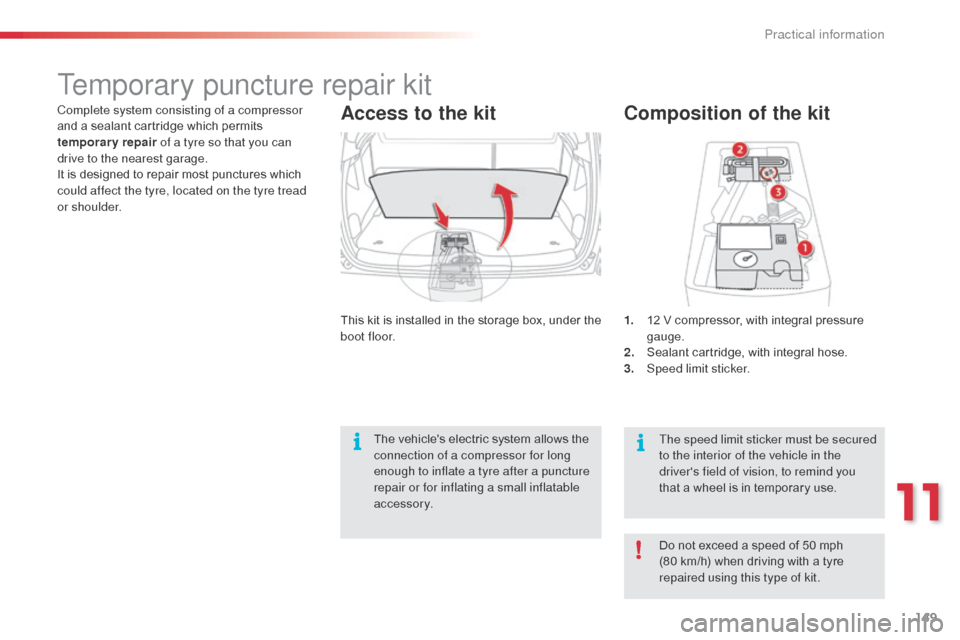
149
Composition of the kit
1. 12 V compressor, with integral pressure gauge.
2.
S
ealant cartridge, with integral hose.
3.
Spe
ed limit sticker.
Access to the kit
This kit is installed in the storage box, under the
boot floor.
The speed limit sticker must be secured
to the interior of the vehicle in the
driver's field of vision, to remind you
that a wheel is in temporary use.
Complete system consisting of a compressor
and a sealant cartridge which permits
temporary repair
of a tyre so that you can
drive to the nearest garage.
It is designed to repair most punctures which
could affect the tyre, located on the tyre tread
or shoulder.
Do not exceed a speed of 50 mph
(80 km/h) when driving with a tyre
repaired using this type of kit.
The vehicle's electric system allows the
connection of a compressor for long
enough to inflate a tyre after a puncture
repair or for inflating a small inflatable
accessory.
Temporary puncture repair kit
11
Practical information
Page 152 of 288

150
F Switch off the ignition.
F S ecure the speed limit sticker inside the
vehicle. F
U ncoil the pipe stowed under the
compressor.
F
C
onnect the pipe from the compressor to
the sealant cartridge.
F
T
urn the the sealant cartridge and secure it
in the cut-out provided on the compressor.
av
oid removing any foreign bodies
which have penetrated into the tyre. F
R emove the valve cap from the tyre to be
repaired, and place it in a clean area.
F
C
onnect the hose from the sealant
cartridge to the valve of the tyre to be
repaired and tighten firmly.
Repair procedure
Practical information
Page 153 of 288
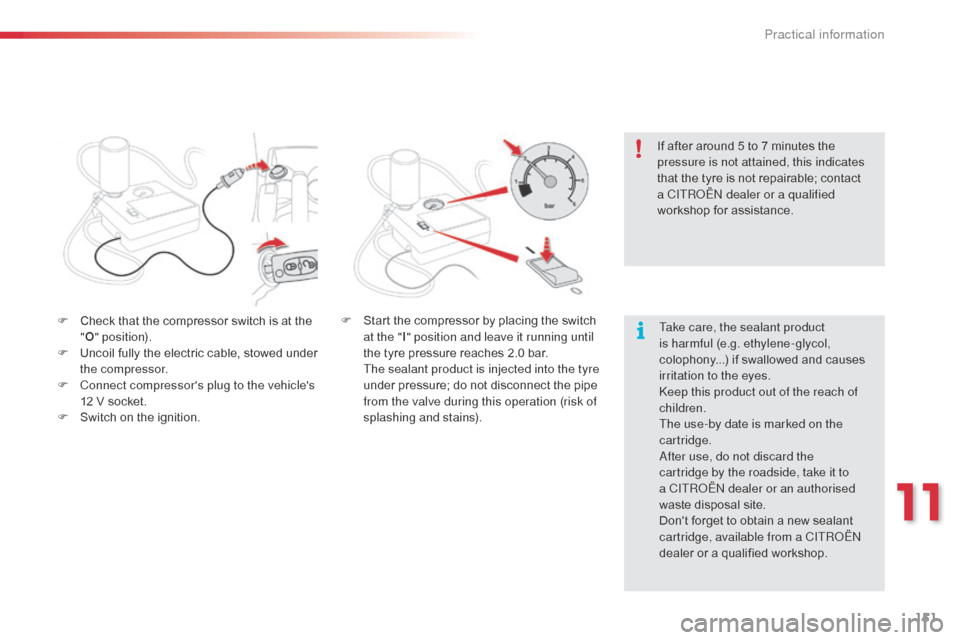
151
F Check that the compressor switch is at the "O " position).
F
U
ncoil fully the electric cable, stowed under
the compressor.
F
C
onnect compressor's plug to the vehicle's
12 V socket.
F
S
witch on the ignition. Take care, the sealant product
is harmful (e.g. ethylene-glycol,
colophony...) if swallowed and causes
irritation to the eyes.
ke
ep this product out of the reach of
children.
The use-by date is marked on the
cartridge.
af
ter use, do not discard the
cartridge by the roadside, take it to
a CITR
oËn
dealer or an authorised
waste disposal site.
Don't forget to obtain a new sealant
cartridge, available from a CITR
oËn
dealer or a qualified workshop.
F
S tart the compressor by placing the switch
at the " I" position and leave it running until
the tyre pressure reaches 2.0 bar.
T
he sealant product is injected into the tyre
under pressure; do not disconnect the pipe
from the valve during this operation (risk of
splashing and stains). If after around 5 to 7 minutes the
pressure is not attained, this indicates
that the tyre is not repairable; contact
a CITR
oËn
dealer or a qualified
workshop for assistance.
11
Practical information
Page 154 of 288
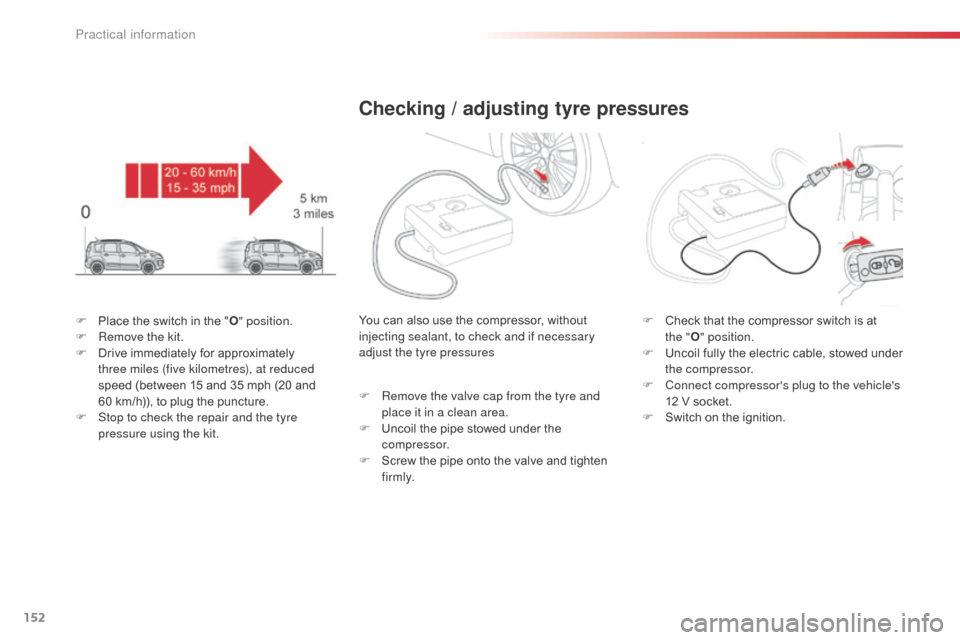
152
F Place the switch in the "O" position.
F R emove the kit.
F
D
rive immediately for approximately
three miles (five kilometres), at reduced
speed (between 15 and 35 mph (20 and
60
km/h)), to plug the puncture.
F
S
top to check the repair and the tyre
pressure using the kit.
Checking / adjusting tyre pressures
You can also use the compressor, without
injecting sealant, to check and if necessary
adjust the tyre pressures
F
R
emove the valve cap from the tyre and
place it in a clean area.
F
U
ncoil the pipe stowed under the
compressor.
F
S
crew the pipe onto the valve and tighten
f i r m l y. F
C heck that the compressor switch is at
the
"O " position.
F
U
ncoil fully the electric cable, stowed under
the compressor.
F
C
onnect compressor's plug to the vehicle's
12 V socket.
F
S
witch on the ignition.
Practical information
Page 155 of 288

153
F Start the compressor by placing the switch at the " I" position and adjust the pressure
to the value shown on the vehicle's tyre
pressure label.
T
o deflate: press the black button on the
compressor pipe, at the valve connector.
F
o
n
ce the correct pressure is reached, put
the switch to the " O" position.
F
R
emove the kit then stow it.
Tyre under-inflation detection
After repair of the tyre, the warning
lamp will remain on until the system is
reinitialised.
For more information, refer to the
"Under-inflation detection" section.
Should the pressure of one or more
tyres be adjusted, it is necessary to
reinitialise the under-inflation detection
system.
Refer to the "Under-inflation detection"
section.
11
Practical information
Page 156 of 288
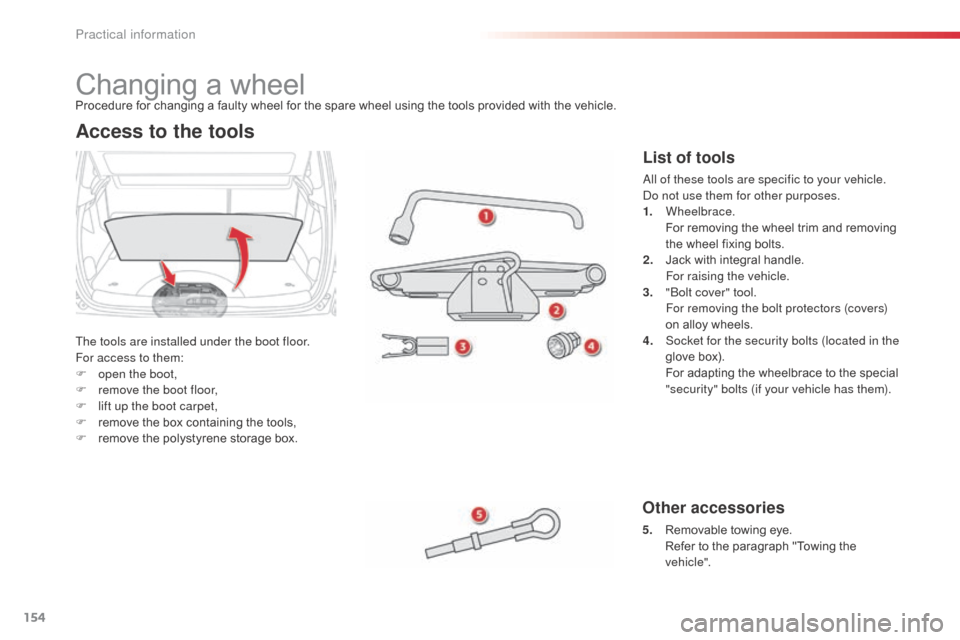
154
Changing a wheel
The tools are installed under the boot floor.
For access to them:
F
o
pen the boot,
F
r
emove the boot floor,
F
l
ift up the boot carpet,
F
r
emove the box containing the tools,
F
r
emove the polystyrene storage box.
Other accessories
5. Removable towing eye. R efer to the paragraph "Towing the
vehicle".
Access to the tools
Procedure for changing a faulty wheel for the spare wheel using the tools provided with the vehicle.
List of tools
all of these tools are specific to your vehicle. do n ot use them for other purposes.
1.
Wheelbrace.
F
or removing the wheel trim and removing
the wheel fixing bolts.
2.
J
ack with integral handle.
F
or raising the vehicle.
3.
"bo
lt cover" tool.
F
or removing the bolt protectors (covers)
on alloy wheels.
4.
S
ocket for the security bolts (located in the
glove box).
F
or adapting the wheelbrace to the special
"security" bolts (if your vehicle has them).
Practical information
Page 157 of 288
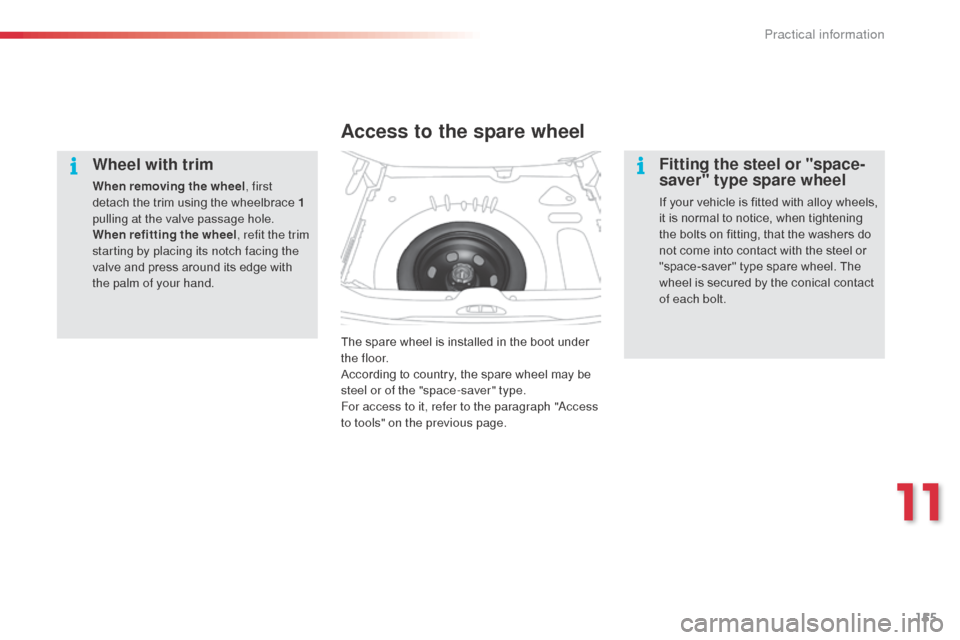
155
Wheel with trim
When removing the wheel, first
detach the trim using the wheelbrace 1
pulling at the valve passage hole.
When refitting the wheel , refit the trim
starting by placing its notch facing the
valve and press around its edge with
the palm of your hand.
Access to the spare wheel
The spare wheel is installed in the boot under
t h e f l o o r.
According to country, the spare wheel may be
steel or of the "space-saver" type.
For access to it, refer to the paragraph "
ac
cess
to tools" on the previous page.
Fitting the steel or "space-
saver" type spare wheel
If your vehicle is fitted with alloy wheels,
it is normal to notice, when tightening
the bolts on fitting, that the washers do
not come into contact with the steel or
"space-saver" type spare wheel. The
wheel is secured by the conical contact
of each bolt.
11
Practical information
Page 158 of 288
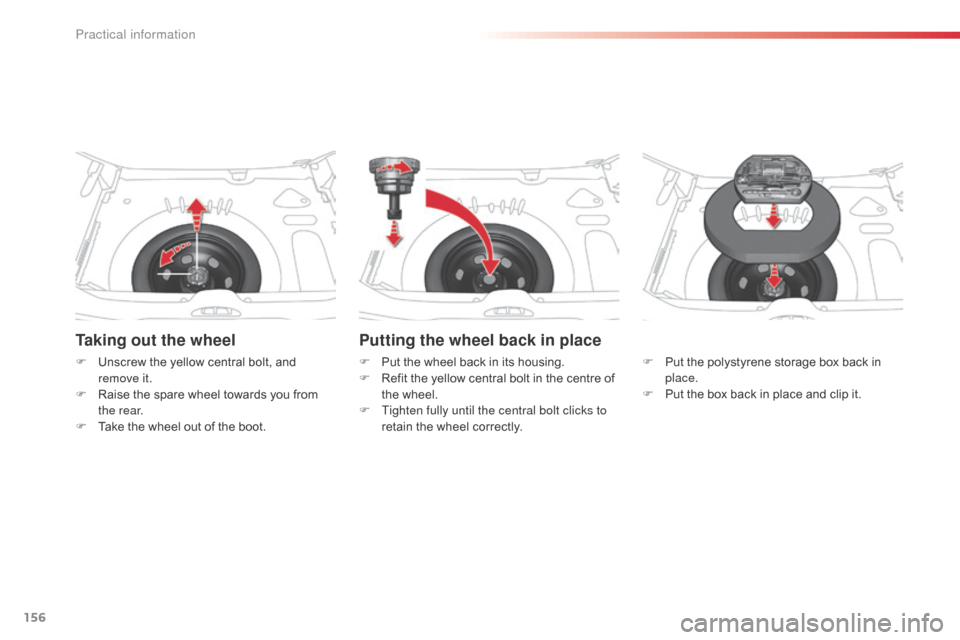
156
Taking out the wheel
F Unscrew the yellow central bolt, and remove it.
F
R
aise the spare wheel towards you from
the rear.
F
T
ake the wheel out of the boot.
Putting the wheel back in place
F Put the wheel back in its housing.
F R efit the yellow central bolt in the centre of
the wheel.
F
T
ighten fully until the central bolt clicks to
retain the wheel correctly. F
P ut the polystyrene storage box back in
place.
F
P
ut the box back in place and clip it.
Practical information
Page 159 of 288
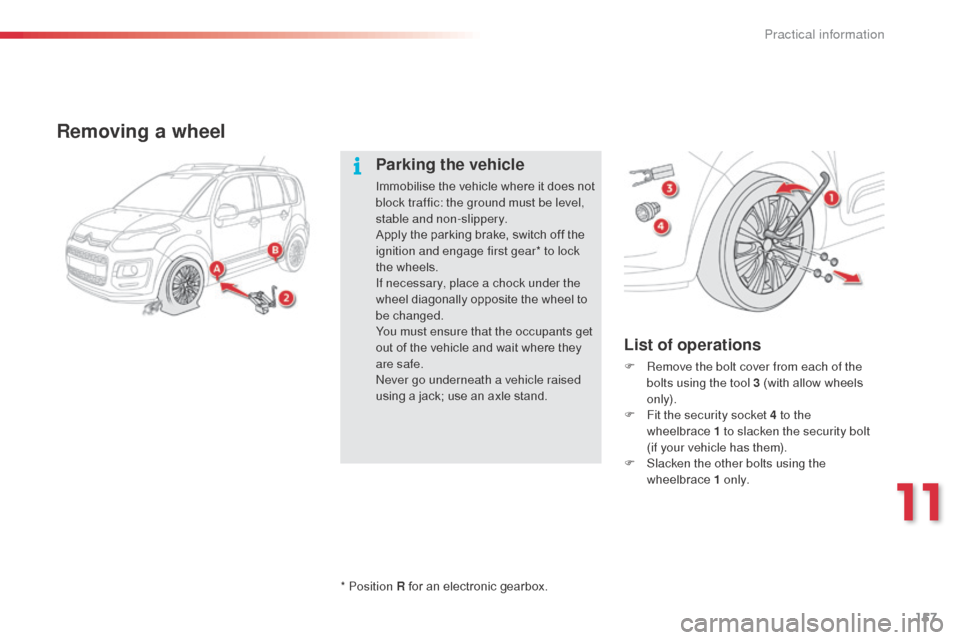
157
Removing a wheel
List of operations
F Remove the bolt cover from each of the bolts using the tool 3 (with allow wheels
only).
F
F
it the security socket 4 to the
wheelbrace
1
to slacken the security bolt
(if your vehicle has them).
F
S
lacken the other bolts using the
wheelbrace 1 o n l y.
Parking the vehicle
Immobilise the vehicle where it does not
block traffic: the ground must be level,
stable and non-slippery.
Apply the parking brake, switch off the
ignition and engage first gear* to lock
the wheels.
If necessary, place a chock under the
wheel diagonally opposite the wheel to
be changed.
You must ensure that the occupants get
out of the vehicle and wait where they
are safe.
ne
ver go underneath a vehicle raised
using a jack; use an axle stand.
* Position R for an electronic gearbox.
11
Practical information
Page 160 of 288
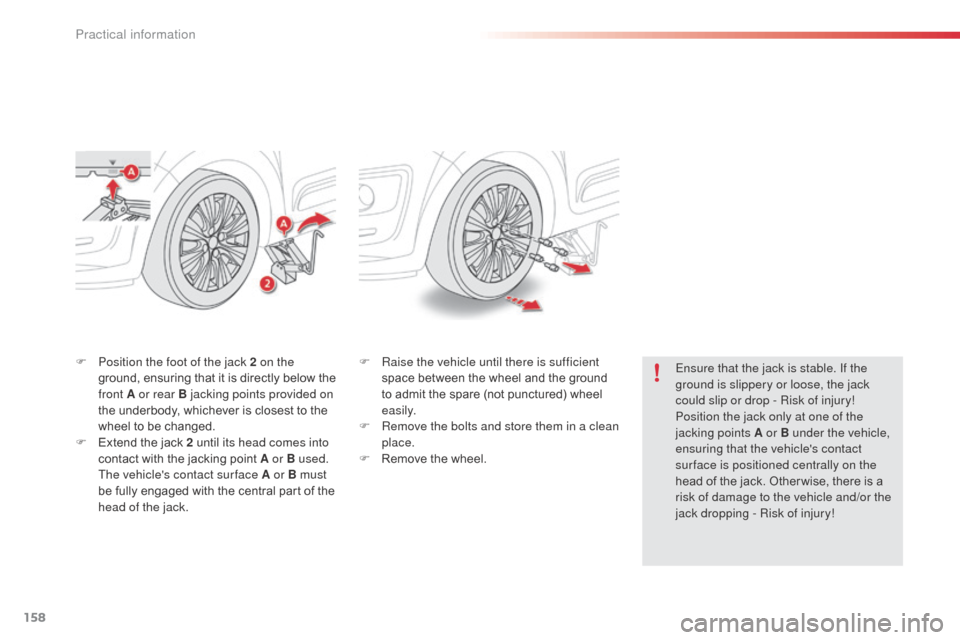
158
F Position the foot of the jack 2 on the ground, ensuring that it is directly below the
front A or rear B jacking points provided on
the underbody, whichever is closest to the
wheel to be changed.
F
E
xtend the jack 2 until its head comes into
contact with the jacking point A or B used.
The vehicle's contact sur face A or B must
be fully engaged with the central part of the
head of the jack. F
Ra ise the vehicle until there is sufficient
space between the wheel and the ground
to admit the spare (not punctured) wheel
easily.
F
R
emove the bolts and store them in a clean
place.
F
R
emove the wheel.Ensure that the jack is stable. If the
ground is slippery or loose, the jack
could slip or drop - Risk of injury!
Position the jack only at one of the
jacking points A or B under the vehicle,
ensuring that the vehicle's contact
sur face is positioned centrally on the
head of the jack. Other wise, there is a
risk of damage to the vehicle and/or the
jack dropping - Risk of injury!
Practical information